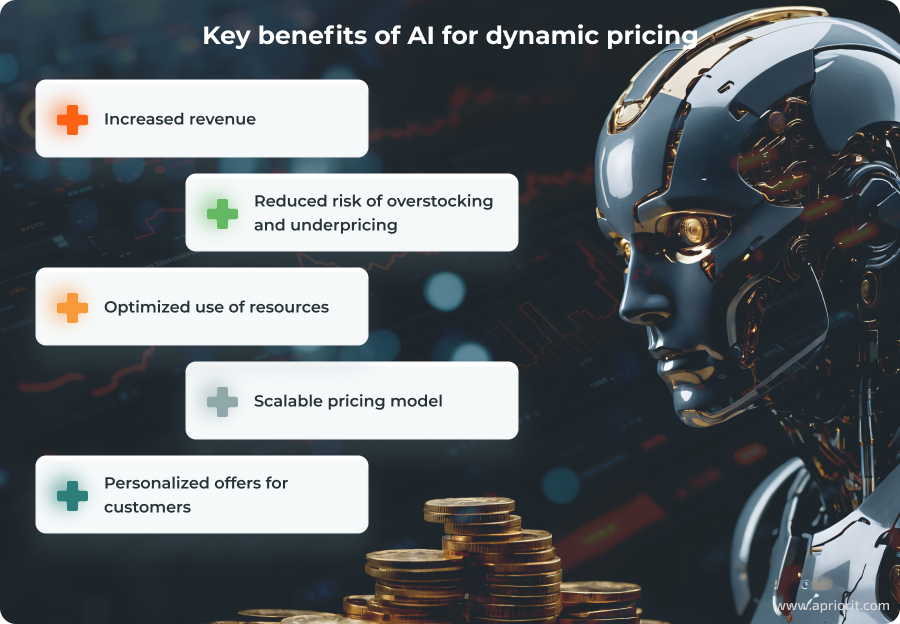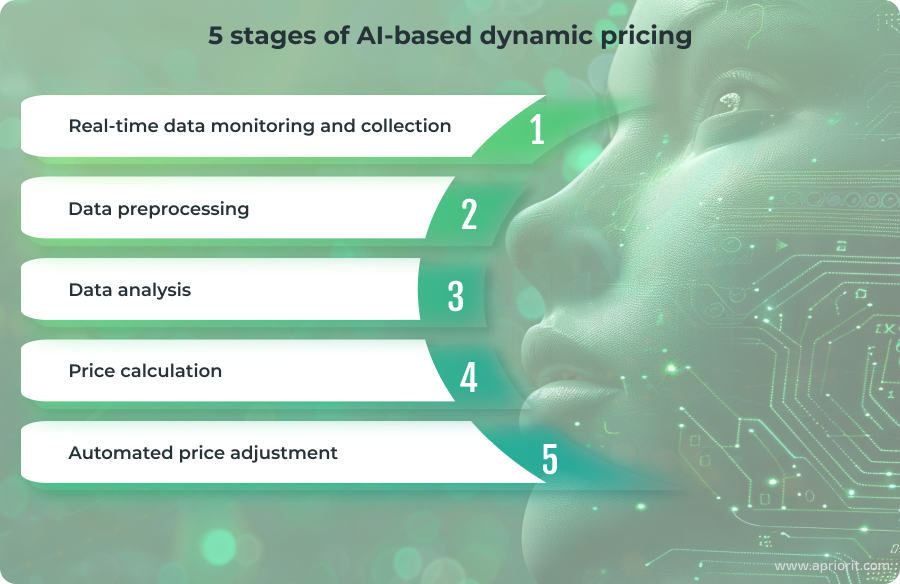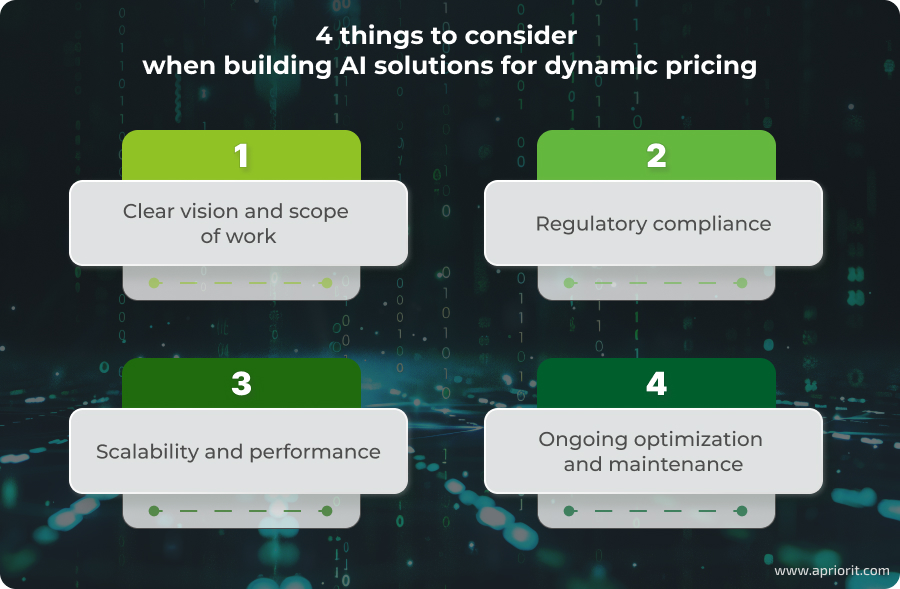Key takeaways:
- Where traditional price adjustment methods fail, AI-powered solutions enable instant and precise adjustments.
- To level up your dynamic pricing strategy, it’s important to choose an AI model that reflects changes in your market niche and meets your business goals.
- You should be ready to deal with implementation challenges including low-quality data, integration issues, and insufficient data protection.
- To ensure the reliability and security of your AI solution, pay attention to regulatory compliance, performance, scalability, and ongoing maintenance.
The modern market demands that businesses react to price changes instantly. AI allows you to adjust prices in real time while automating the pricing process.
But do you really need AI to build a responsive and efficient pricing strategy? Will your business benefit from it, or will the implementation challenges outweigh the possible gains?
In this article, we analyze key aspects to consider before investing in a custom AI-powered dynamic pricing solution: from use cases across industries to implementation obstacles and ways to overcome them.
If you are a technical or product leader thinking of enhancing your dynamic pricing strategy with AI, this article will give you valuable expert insights.
Contents:
- How AI improves dynamic pricing
- Key benefits of AI for dynamic pricing
- Use cases for AI-powered dynamic pricing across industries
- How AI solutions for dynamic pricing work
- 5 AI models for dynamic pricing
- Challenges of using AI for dynamic pricing
- What else should you consider?
- How Apriorit can help you with building an AI solution for dynamic pricing
- Conclusion
How AI improves dynamic pricing
Dynamic pricing involves setting flexible prices for products and services depending on the market situation. Prices can change in response to shifts in demand, supply, competitor pricing, and other external factors. For example, supermarkets can apply dynamic pricing for products with limited shelf lives by setting the highest price for the freshest goods and offering discounts as the expiry date approaches.
A traditional dynamic pricing approach mostly relies on historical data and market studies. It requires manual and irregular price adjustments that often fail to reflect the real-time market situation.
AI-based dynamic pricing solutions can process large, diverse datasets faster and more consistently than manual methods. They enable granular segmentation and high-frequency price optimization by processing data on things such as:
- Historical sales
- Customer behavior
- Willingness to pay
- Market trends
Allowing for automated price updates, this approach ensures your pricing strategy remains dynamic, profitable, and aligned with customer expectations.
Moreover, the ability of machine learning (ML) algorithms to identify hidden patterns in historical and real-time data and predict future trends helps you alter prices more precisely.
Along with the possibility of adjusting prices on the fly, dynamic AI pricing solutions provide a range of business benefits that we’ll examine in the next section.
Want to incorporate AI into your dynamic pricing strategy?
Delegate the development of your custom AI-powered dynamic pricing solution to Apriorit experts.
Key benefits of AI for dynamic pricing
Before implementing AI technologies for dynamic pricing, it’s essential to analyze all the pros and cons, which will primarily depend on your industry and other factors. These are the core benefits that most businesses can expect:

- Increased revenue. With real-time analysis of data from various sources, you can promptly and precisely optimize prices during periods of peak and low demand to maintain or even increase your revenue.
- Reduced risk of overstocking and underpricing. By linking AI algorithms with inventory data, you can lower prices for overstocked items to promote sales and raise prices for high-demand products.
- Optimized use of resources. Eliminating manual data analysis can lower the number of errors while building your pricing strategy and accelerate its adjustments. It also helps you free up resources and streamline their use.
- Scalable pricing model. An AI solution’s ability to process and accommodate large amounts of data, from usage patterns to product catalogs, allows you to scale your pricing model seamlessly when your business expands.
- Personalized offers for customers. Customizing your pricing strategy based on customers’ preferences allows you to define their needs and provide personalized offers and discounts. This approach will let you retain customers and enhance their loyalty.
These benefits have caused interest in integrating AI for dynamic pricing in various industries.
Use cases for AI-powered dynamic pricing across industries
How you implement dynamic pricing using AI will differ depending on your industry. Here are key factors that impact pricing in various industries, including real-life examples:
Retail and e-commerce. Changing product prices in real time based on demand, competitor pricing, inventory levels, and customer behavior allows retail businesses to boost sales and profitability, personalize prices to provide customer-specific offers, and handle inventory efficiently. For example, Amazon may adjust the price of a given item many times per day, which allows it to make compelling offers faster than other retailers.
Transportation and logistics. Freight and trucking companies use AI solutions to adjust prices for delivery services depending on demand, fuel costs, available capacity, and weather conditions. This helps them increase revenue during high-demand periods and remain competitive during slow times. Ride-sharing companies like Uber apply surge pricing to balance supply and demand by raising prices during peak times or in locations with few drivers. This limits demand to those willing to pay more and attracts more drivers to serve high-demand areas. When demand subsides, prices also drop.
Travel and hospitality. In this sphere, AI calculates and adjusts prices for rooms, tickets, and vacation packages in real time. AI analyzes historical booking trends, seasonality, weather forecasts, flight arrival patterns, competitor prices, and local events to predict demand days or weeks in advance. For example, Airbnb’s Smart Pricing feature automatically adjusts nightly rates based on demand, seasonality, and local events to maximize occupancy and competitiveness. AI solutions are also used to calculate restaurant menu prices by monitoring fluctuations in ingredient costs and supply chain factors to maintain profitability.
Energy. AI systems continuously analyze grid load, generation capacity, consumption patterns, and market conditions to optimize electricity pricing in real time, balancing supply and demand, improving grid efficiency, and promoting sustainable consumption.
Healthcare. Price elasticity, competitor actions, and customer behavior are the factors AI solutions consider when setting medication prices that balance commercial viability with accessibility. For example, integrating an AI solution for dynamic pricing allowed a leading pharmaceutical company to enhance its responsiveness to market fluctuations, leading to a more substantial market presence and optimized pricing strategies.
Finance. AI solutions aim to optimize pricing of financial products and services such as loans, insurance policies, and transaction fees. They analyze borrower credit scores, market interest rates, economic indicators, and the competitive landscape to attract more users while optimizing revenue.
So, what makes AI solutions for dynamic pricing so efficient?
Read also
AI in FinTech: Trends, Use Cases, Challenges, and Best Practices
Learn how to implement secure and compliant AI software in FinTech.

How AI solutions for dynamic pricing work
To explore the process of AI-driven dynamic pricing, let’s break it down into five main stages:

1. Real-time data monitoring and collection
To dynamically adjust prices, an AI solution continuously monitors and collects data from multiple sources. Diversity of data allows for a comprehensive picture of factors that impact pricing. The most popular sources of data are sales records, competitor pricing strategies, and customer behavior.
2. Data preprocessing
This stage involves cleaning the collected data from errors and inconsistencies to improve overall data quality, leading to increased accuracy of the AI solution. Engineers conduct data preprocessing by applying different techniques, such as outlier detection, deduplication, and normalization. Then, the cleansed data is arranged into formats suitable for further analysis by AI.
3. Data analysis
The preprocessed data undergoes deep analysis through an ML algorithm, which discovers hidden patterns to enable accurate demand forecasting, estimates price elasticity to set optimal prices without losing sales, and simulates pricing scenarios to understand potential outcomes.
4. Price calculation
After analyzing data and considering all the factors that impact pricing, an AI solution calculates an optimal price for every product or service given the real-time market situation.
5. Automated price adjustment
The system updates prices automatically (and instantly) across all business platforms, ensuring a quick response to shifts in demand, discounts, or supply changes. This process repeats over and over to provide a prompt response to market fluctuations and ensure your pricing strategy works for you.
But to be sure that your AI solution correctly reflects changes in your market niche and meets your business goals, it’s essential to pick a suitable AI model. Let’s explore what AI models for dynamic pricing exist and how they differ.
5 AI models for dynamic pricing
Since there are various approaches to dynamic pricing, there is no universal AI solution for it. Your choice of AI model will depend on your business specifics and strategy. Here are five well-known dynamic AI pricing models you can consider:
- Regression models analyze linear relationships and aim to forecast demand for products and services under different scenarios. Depending on the demand, you can adjust your pricing strategy and set optimal prices. For example, to set accommodation prices, Airbnb leverages regression models to estimate demand, which varies over time (affected by seasonality and events) and across listings.
- Time-series forecasting models analyze patterns such as trends, seasonality, and cyclic behavior in sales data to forecast demand. For example, energy companies use time-series forecasting to predict consumption patterns, which allows them to adjust their pricing during periods of high demand.
- Reinforcement learning (RL) models use machine learning to determine optimal pricing strategies based on the relationship between price and demand. RL models can adapt and learn from ongoing market dynamics, which makes them effective for handling complex pricing environments with multiple factors.
- Bayesian models apply probabilistic reasoning to pricing decisions, incorporating prior knowledge and updating it with new data. This makes them especially effective for uncertain and data-sparse environments.
- Decision tree models split data into branches based on seasonality, promotions, inventory levels, and market conditions. This helps you identify which factors most affect pricing and demand and apply different pricing strategies to every data branch.
Once your team has chosen the model, they should address a few specific challenges during implementation.
Read also
AI for Demand Forecasting: Benefits, Use Cases, and Implementation Tips
Find out what AI solution for dynamic pricing will fit your business: off-the-shelf or custom.

Challenges of using AI for dynamic pricing
Despite AI’s advanced capabilities, incorporating AI into your dynamic pricing solution often comes at a price. Challenges to expect along the way include:
1. Low data quality
Using incomplete, outdated, biased, or false data results in inaccurate, unreliable AI outputs and may decrease the whole solution’s performance.
Best practices for ensuring data quality:
- Collect representative and diverse data from reliable sources
- Clean and preprocess data: handle outliers, remove duplicates, correct inaccuracies, standardize data formats
- Assess datasets for biases
- Automate data validation
- Continuously monitor and fine-tune your AI model
2. Insufficient amount of quality and relevant data
The amount of data you need may depend on your business goals and the AI model you use. More data enhances the accuracy of an AI model, enabling it to recognize complex patterns and make more informed and comprehensive analyses.
You can use various strategies to get diverse and representative data:
- Integrate APIs to get data from websites and external platforms
- Use data augmentation and synthetic data generation
- Use public and open sets of data
- Collect data from surveys and customer feedback
- Use data from browsing history and purchase patterns to track customer behavior
However, it’s important to consider that simply increasing the volume of data without attention to quality can introduce noise, errors, and biases.
3. Integration issues
Lack of support for AI solutions in legacy infrastructure, computational and interoperability limitations of infrastructure, and a shortage of staff skilled in AI deployment and maintenance can all be obstacles to successfully integrating your AI solution into an existing system.
To overcome integration issues:
- Analyze your existing system to discover potential integration issues up front
- Integrate your AI solution iteratively, making incremental improvements
- Use APIs and middleware to ensure a smooth and incremental integration process
- Create in-house training programs to develop your team’s skills
4. Poor data privacy and solution security
Extensive adoption across various industries makes AI systems attractive to threat actors. Threats that target AI software include data poisoning, AI solution theft, and adversarial attacks.
To protect sensitive data and ensure your solution’s security, it’s essential to follow cybersecurity best practices and take advanced security actions such as:
- Implementing strict data validation protocols to detect anomalies and monitor data pipelines in real time
- Simulating attack scenarios to train your AI model to identify and respond to threats
- Providing strong authentication measures to protect the system’s entry points
- Ensuring anonymization to secure sensitive data
- Implementing role-based access controls
- Encrypting data to protect it from unauthorized access when stored and in transit
- Securing APIs and endpoints
- Performing regular security audits to discover potential security risks and system updates
If left unaddressed, these challenges can jeopardize your project’s implementation. For example, inaccurate predictions may lead to inadequate prices, which will cause a loss of revenue and customer loyalty. But they aren’t the only aspects your development team should pay attention to when enhancing your pricing strategy with AI.
Read also
Challenges in AI Adoption and Key Strategies for Managing Risks
Learn what risks you can face when incorporating AI into your business and how you can address them effectively.

What else should you consider?
Here are some expert tips on what to account for when adding AI capabilities to your dynamic pricing solution:

Clear vision and scope of work. Before building your AI-powered dynamic pricing product, you should have a clear vision of the goals you want to achieve, such as increasing profit margins or sales volume, or improving the elasticity of demand. You should also have a clearly defined scope of work. Without these, your team will face problems when deciding what tasks to work on and what features to implement, leading to unreasonable resource expenditures during development.
Apriorit tip: Conducting a discovery phase before starting development will help you determine the direction of your AI project. This will also give you an understanding of potential risks, the scope of work, and accurate estimates of resources needed to build your software.
Regulatory compliance. When building an AI solution, it’s essential to follow laws and regulations, such as GDPR and the EU AI Act, that govern data privacy. You also need to consider principles of responsible AI and sector-specific standards.
Moreover, in many countries, AI-based pricing strategies are subject to laws on pricing fairness and transparency. For example, anti-price discrimination laws, consumer protection laws, and price disclosure requirements aim to monitor prices and prevent price manipulation. Businesses that incorporate AI solutions for pricing must ensure that their pricing algorithms comply with legal requirements and ethical principles.
Apriorit tip: Before implementing an AI pricing solution, it’s important to get acquainted with general and business-specific regulatory compliance requirements. You can use checklists and perform regular audits to ensure your AI software meets all relevant requirements. It’s also crucial to consider the ethics of your dynamic pricing strategy, even if your solution is not subject to regulations in your country.
Scalability and performance. It’s paramount for AI-powered dynamic pricing solutions to process large sets of data in real time. To make this happen, you need to design for scaling and high performance at the architectural level.
Apriorit tip: There are different ways to ensure your AI solution’s scalability and performance. For example, using cloud-native infrastructure allows you to perform auto-scaling as your business expands. A modular architecture provides you with independent scaling of modules on demand. Finally, if what you need is efficient horizontal scaling during traffic spikes, you should go with containerization. Depending on your project needs and goals, you can also choose a lightweight AI model, such as decision trees, whose performance is higher than heavier deep learning models.
Ongoing optimization and maintenance. An AI-based solution’s effectiveness for dynamic pricing depends on its ability to reflect constantly changing factors and provide optimal prices in real time. To maintain accuracy, it’s important to continually adapt your AI model to fluctuating market environments.
Apriorit tip: Regular refinement of your AI model will help you correct biases, address inaccuracies, and improve prediction quality. Moreover, continuously monitoring and updating your AI model with new data will ensure that your pricing strategy stays aligned with market changes. To do this, you can use different metrics, such as average order value, to identify areas where your AI model needs to be adjusted and fine-tune the model parameters.
To address all these considerations and overcome the challenges, sometimes it’s not enough to engage only the in-house team. Some tasks require expert skills and solid knowledge of AI and ML technologies, and in this case it’s easiest to outsource them to professionals.
How Apriorit can help you with building an AI solution for dynamic pricing
With deep expertise in AI and ML software development, we are ready to provide you with a full range of services, from preparing project estimates to maintaining and fine-tuning your AI solution after release.
- Conducting a discovery phase. During the discovery phase, we help you define clear project goals, assess the scope of work, and prepare resource estimates before development starts.
- Building a secure AI-powered solution. We follow cybersecurity best practices and adhere to the principles of a secure SDLC at every stage of software development to ensure reliability and effectiveness.
- Meeting regulatory requirements. We study regulations applicable to your project and monitor your AI product to make sure it meets all compliance requirements throughout the development process.
- Selecting an AI model. We can help you choose the AI model that most closely matches your business needs and goals.
- Preparing datasets and training ML algorithms. Our team will customize the selected AI model to ensure it provides precise analysis results and considers all factors relevant to your industry and business objectives.
- Integrating an AI solution. We can assist in integrating your AI software with your existing infrastructure to guarantee its smooth operation and expected results.
- Conducting security audits. We can perform security testing to discover vulnerabilities in your AI software before attackers exploit them.
- Performing comprehensive testing. Our testing team will check your AI solution for bugs to guarantee its high quality and maximize product performance.
- Providing continuous maintenance and support. We can arrange ongoing maintenance of your AI solution after release to ensure its predictions are precise.
Conclusion
AI offers excellent opportunities to make your dynamic pricing strategy profitable and responsive to market fluctuations.
However, building a reliable and secure AI solution for dynamic pricing requires thorough preparation — and often the involvement of an experienced vendor to cope with non-trivial tasks. Following our tips from Apriroit experts will help you handle possible implementation issues more efficiently.
If you need to outsource challenging tasks, turn to Apriorit’s AI and cybersecurity experts. We will provide comprehensive AI consulting services and help you build software that meets your goals and regulatory requirements.
Looking for a reliable partner to outsource AI software development tasks?
Apriorit experts in AI and ML are ready to create a reliable AI project with security in mind.


